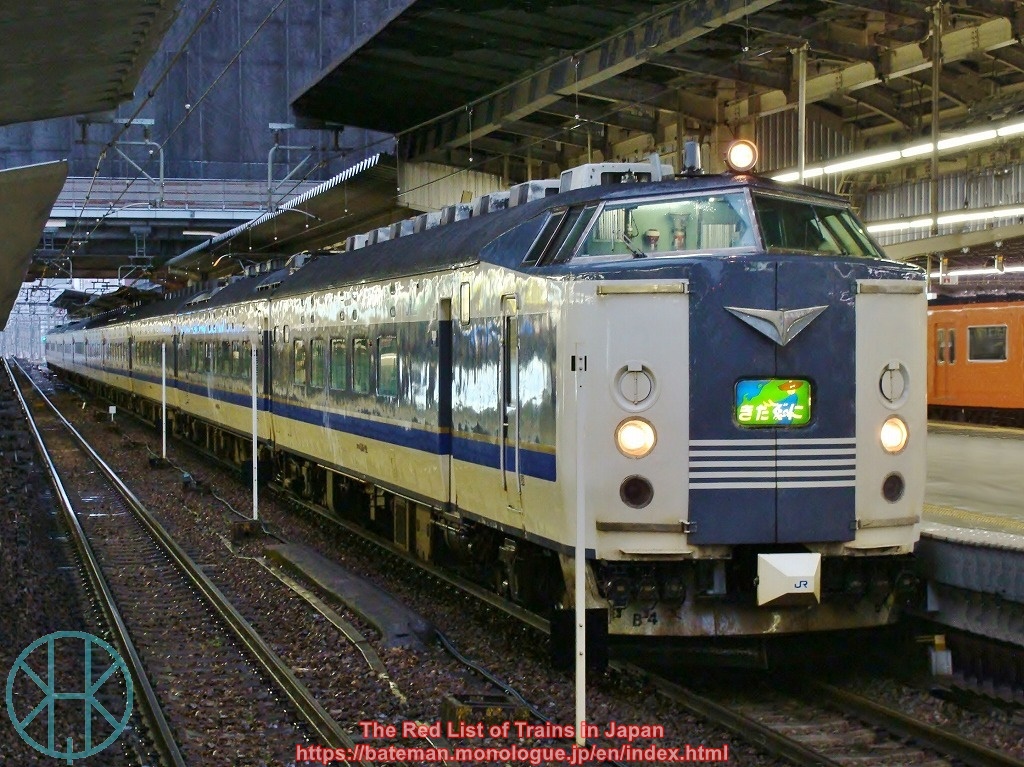JNR 583 series

Data (as of 17 Jun 2022)
| Status: | Extinct |
| Constructed in: | 1967-72 |
| Number built: | 434 |
| Retired in: | 2017 |
History
The 583 series was a type of dual-voltage limited express EMU. It was one of the most unique train that Japanese National Railways developed, as transverse seating could be transformed to three-bunk bed. The series were used for various limited express and express services, both in daytime and at night, and sometimes as a sleeper train.
As the demand soared in the 1960s, JNR had to introduce more trains, but the lack of capacity at depots did not allow JNR to do so. Engineers considered that if a train could be used both as ordinary and sleeper train, there would be no need to construct new depots. Therefore, JNR designed the 583 series based on 485 series. Those introduced in 1967 were called 581 series, which were compatible with DC 1.5 kV and AC 20 kV (60 Hz), but those introduced after were called the 583 series and also compatible with AC 20 kV (50 Hz). The 581 series was first introduced to Limited Express Midori (Shin-Osaka - Hakata) and Sleeper Limited Express Gekko (Shin-Osaka - Oita).
The 583 series trains were also used on Tohoku Main Line, such as Limited Express Hatsukari (Ueno - Aomori) and Sleeper Limited Express Hakutsuru (same route). Those introduced to the west were widely used in Kyushu as well, like Limited Express Tsubame (Nagoya - Kumamoto). As these service patterns suggested, the 583 series were used for long-distance services from Aomori in the north to Kagoshima in the south, consisted of up to 13 coaches including a dining car.
However, the 583 series suddenly dwindled in 1982, when Tohoku Shinkansen high-speed rail was opened. The new bullet train route made more than a hundred carriages redundant. Dining cars were scrapped as they were no longer necessary, while others were converted to suburban trains 419 series (Hokuriku Main Line) and 715 series (Tohoku and Kyushu regions). Since the 583 series were for limited express services, the 419 and 715 series had small doors and aisles with poor acceleration. All carriages of the 581 series, which were not compatible with AC 20 kV 50 Hz, were converted to the 715 series.
The decline of the 583 series did not end there. On the one hand, JNR had no choice but to reduce sleeper trains, to downsize the business due to a huge deficit. On the other hand, the distinctive accommodation became unpopular by the late-1970s, as the transverse seating without reclining feature was simply out of date, and the three-bunk bed was too small and made passengers wondering what to do before going to bed and after awaking. Furthermore, the series were heavily used day and night, meaning that their condition deteriorated faster than other trains.
When the JNR was privatised in 1987, 208 carriages were distributed to JR Hokkaido, East and West. JR Hokkaido succeeded seven intermediate carriages, which had been stored at a depot and deregistered in 1990.
JR East used them for Limited Express Hatsukari (Morioka - Aomori), Sleeper Limited Express Hakutsuru (Ueno - Aomori via Tohoku Main Line) and Yuzuru (Ueno - Aomori via Joban Line), but all regular services provided by the 583 series were discontinued by 1994. Since then, they had been used for seasonal services and rail tours, including excursion trains from Akita to Tokyo Disney Resort. Most carriages were scrapped by 2001, but very few remained until 2017.
JR West used them for Night Express Kitaguni (Osaka - Niigata). They were also used for seasonal trains to and from ski resorts in winter. Unlike JR East, JR West repainted them sky blue in 1993 when refurbished the units, but soon repainted again to grey with white stripes by 1998. Kitaguni was the last regular service of the 583 series, but it became a seasonal train in 2012 and withdrawn in the next year.
The 419 and 715 series, types of suburban train converted from the 581 and 583 series, were not successful. As mentioned above, they were not designed to carry commuters, and their condition was bad. JR East, West and Kyushu succeeded them, but JR East and Kyushu withdrew all carriages by 1998. JR West retained the 419 series until 2012.
Photos

JR East's units were frequently observed in Greater Tokyo Area as mentioned above.

Express Kitaguni arrived at Osaka after an eight-hour journey from Niigata.
(Updated: 17 Jun 2022)
